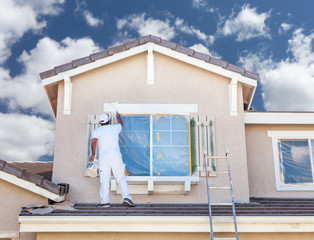Residential painting is one of the most effective ways to enhance the appearance, value, and comfort of a home. Whether refreshing a single room, updating the exterior, or undertaking a full home makeover, painting can dramatically transform a living space. Beyond aesthetics, a well-executed paint job protects surfaces, improves durability, and contributes to a healthier home environment. Understanding the benefits, preparation, techniques, and maintenance of residential painting ensures a beautiful and long-lasting finish.

The Importance of Residential Painting
Painting is more than a cosmetic improvement; it provides both practical and aesthetic benefits. Some of the key advantages include:
- Enhanced curb appeal – Fresh exterior paint creates a striking first impression, boosting property value and visual appeal.
- Protection of surfaces – Paint acts as a barrier against moisture, UV rays, and general wear and tear, preserving walls, trim, and siding.
- Interior atmosphere – Colors can dramatically influence mood, lighting, and the perceived size of rooms, enhancing comfort and livability.
- Cost-effective renovation – Compared to major remodeling projects, painting offers a relatively affordable way to refresh and modernize a home.
- Maintenance and longevity – Regularly painting and updating surfaces helps prevent cracks, peeling, and other damage that can lead to costly repairs.
Investing in professional residential painting improves both the aesthetic and functional aspects of a property.
Choosing the Right Colors
Selecting the right colors is a critical step in residential painting. Color choices impact both the appearance and feel of a home:
- Interior colors – Consider lighting, room size, and intended use. Light colors can make small spaces feel larger, while warm tones create a cozy atmosphere. Accent walls and complementary color schemes can add depth and character.
- Exterior colors – Choose shades that harmonize with the architectural style, surrounding landscape, and neighborhood aesthetics. Durable, weather-resistant paint is essential for maintaining vibrancy over time.
- Finish selection – Different finishes, such as matte, satin, semi-gloss, or gloss, affect durability and appearance. High-traffic areas may benefit from more durable, washable finishes.
Thoughtful color selection ensures a cohesive, visually appealing, and harmonious home environment.
Preparing for a Painting Project
Proper preparation is key to achieving a smooth, long-lasting finish. Steps include:
- Surface cleaning – Remove dirt, grease, and mold to ensure paint adheres properly.
- Repairing imperfections – Fill cracks, sand rough spots, and replace damaged materials for a uniform surface.
- Priming – Applying primer enhances paint adhesion, improves coverage, and prevents stains from showing through.
- Protecting furnishings and floors – Use drop cloths, tape, and protective coverings to avoid accidental paint splatters.
- Planning logistics – Determine the painting sequence, equipment needs, and estimated timeline for efficient project completion.
Thorough preparation reduces errors, improves finish quality, and extends the life of the paint job.
Techniques for Professional Results
Residential painting requires skill and attention to detail to achieve a flawless appearance:
- Brush and roller application – Essential for achieving smooth, even coverage on walls, trim, and ceilings. High-quality brushes and rollers improve efficiency and reduce streaks.
- Spray painting – Ideal for large surfaces, cabinets, or textured areas, providing a consistent finish while saving time.
- Cutting in – Carefully painting edges, corners, and trim ensures sharp lines and a professional appearance.
- Multiple coats – Applying two or more coats enhances durability, color richness, and coverage, especially when changing from dark to light colors.
- Proper drying times – Allowing paint to dry completely between coats prevents peeling, uneven texture, or bubbling.
Employing proper techniques ensures a polished, professional result that lasts for years.
Benefits of Hiring Professional Painters
While some homeowners attempt DIY projects, professional painters offer several advantages:
- Expertise and experience – Professionals understand paint types, surfaces, and techniques to achieve high-quality results.
- Time efficiency – Skilled painters complete projects faster without compromising quality.
- Access to quality materials – Professionals use durable paints, primers, and tools that may not be available to the general public.
- Attention to detail – Experienced painters deliver clean lines, smooth coverage, and proper surface preparation.
- Safety – Professionals follow safety protocols for ladders, scaffolding, ventilation, and toxic materials.
Hiring experts ensures that painting projects are completed efficiently, safely, and with a lasting professional finish.
Maintaining Painted Surfaces
Proper maintenance helps preserve the appearance and longevity of both interior and exterior paint:
- Regular cleaning – Wipe walls, trim, and surfaces to remove dust, dirt, and stains.
- Touch-ups – Address minor chips, scratches, or fading promptly to prevent further damage.
- Inspect for moisture – Identify leaks or water damage early to avoid peeling or mold growth.
- Repainting schedule – Most interior walls benefit from repainting every 5–7 years, while exterior surfaces may need touch-ups or full repainting every 7–10 years, depending on climate and exposure.
Consistent care ensures that painted surfaces remain vibrant, durable, and visually appealing.
Eco-Friendly Painting Options
Many homeowners are now prioritizing environmentally friendly choices:
- Low-VOC paints – Reduce harmful emissions and improve indoor air quality.
- Sustainable materials – Using paints and primers made from natural or recycled components minimizes environmental impact.
- Efficient cleanup – Proper disposal of paint and cleaning materials reduces environmental contamination.
Eco-conscious painting practices protect both the home environment and the broader ecosystem.
Residential painting is a transformative investment that enhances beauty, comfort, and property value. From thoughtful color selection to meticulous surface preparation, proper techniques, and ongoing maintenance, every step contributes to a lasting, professional finish.
Whether updating a single room or completing a full-home exterior refresh, painting is a cost-effective, impactful way to create a welcoming, attractive, and durable living environment. With careful planning, attention to detail, and, when appropriate, professional support, residential painting delivers spaces that homeowners can enjoy for years to come.